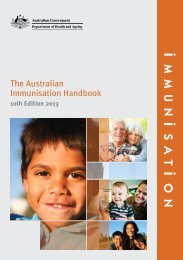3.30 MB - Academy of Medicine of Malaysia
3.30 MB - Academy of Medicine of Malaysia
3.30 MB - Academy of Medicine of Malaysia
Create successful ePaper yourself
Turn your PDF publications into a flip-book with our unique Google optimized e-Paper software.
3.2.4 Special issues for adolescents<br />
MANAGEMENT OF HIV INFECTION IN CHILDREN<br />
Adolescents diagnosed with HIV infection have either been infected by<br />
horizontal transmission (sexual, injecting drug use) or are adolescent<br />
survivors <strong>of</strong> perinatal infection.<br />
Differences have been described in the natural history and progression <strong>of</strong><br />
HIV infection in adolescents when compared with adults. Although<br />
adolescents may be more susceptible to HIV infection, they have better<br />
thymic reserve, demonstrate less rapid disease progression and perhaps<br />
211, Level 8<br />
better immune reconstitution with treatment.<br />
Adolescence is a time <strong>of</strong> rapid physical, cognitive and social changes which<br />
may influence disease progression and ongoing care. Combined management<br />
with an adolescent physician is beneficial. Important elements <strong>of</strong> care<br />
include access to age-appropriate health care, mental health and substance<br />
abuse services, peer-to-peer support, sexual health, routine screening for<br />
sexually transmitted infections, risk reduction counselling and contraceptive<br />
counselling. Routine cervical screening should be included for adolescent<br />
girls and the possible use <strong>of</strong> HPV vaccines should be considered.<br />
a) Antiretroviral therapy<br />
Timing and choice <strong>of</strong> therapy have been outlined in the respective sections.<br />
Particular problems in the adolescent include possible extensive prior treatment<br />
for perinatally acquired disease, drug resistances and regimen failures and<br />
issues <strong>of</strong> sustaining adherence. In the PACTG 381 study, 212, Level 8 only 24% <strong>of</strong><br />
adolescents on HAART were completely adherent to their regimen.<br />
b) Dosing<br />
It is recommended that prepubescent adolescents (Tanner stage I or II)<br />
should be dosed according to paediatric guidelines while those in late puberty<br />
(Tanner stage V) should receive adult doses. Refer Appendix 5 for details on<br />
Tanner staging<br />
c) Adolescent Females<br />
Gynecological care is an important part <strong>of</strong> care for the HIV infected female<br />
adolescent. Adolescents with HIV infection may be sexually active, therefore<br />
contraception and prevention <strong>of</strong> HIV transmission should be discussed,<br />
including the interaction <strong>of</strong> specific ARV drugs with hormonal contraceptive<br />
agents. The potential for pregnancy must be considered and this may alter<br />
choices <strong>of</strong> antiretroviral therapy. For example, efavirenz should be used with<br />
caution in females <strong>of</strong> child bearing age and should only be prescribed after<br />
intensive counselling and education about the potential effects on the<br />
foetus. PMTCT strategies and regimens during pregnancy are described in<br />
the relevant CPGs.<br />
38

















